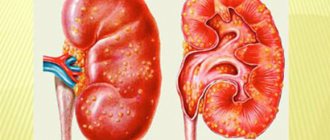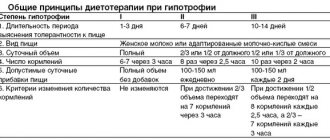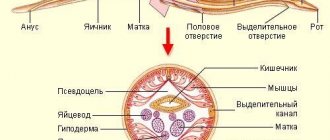- bowel disorders (constipation and diarrhea);
- rumbling in the stomach accompanied by bloating;
- flatulence;
- increased salivation, especially during sleep;
- attacks of nausea and sometimes vomiting;
- change in appetite down or up;
- constant discomfort in the abdomen and pain in the navel;
- rash on the body;
- itching in the anus;
- emaciation;
- pale skin;
- restless sleep.
Symptoms of worm infection Such symptoms may be limited to ascariasis and enterobiasis. With more dangerous worms, signs of severe intoxication appear. The child complains of headache, dizziness, weakness. With pulmonary localization, children suffer from cough and shortness of breath, with hepatic localization - pain in the right hypochondrium. If worms infect the brain, seizures and fever may develop. Invasions in adolescents lead to memory impairment and decreased academic performance.
Important!
Symptoms of worms in children differ in the degree of manifestation and can be mistaken for other pathologies. Only a doctor can make a correct diagnosis using a comprehensive examination.
Routes of invasion
Worms in a child’s body cause a lot of harm if the infestation is not treated promptly. The eggworm easily penetrates into the baby’s body, where, once in a favorable environment, it quickly matures, reaches sexual maturity and reproduces. There are such ways that helminths enter a child’s body:
- Enterobiasis is contracted through contact with an infected carrier and objects touched by a sick person. Small children under one year old are constantly trying to taste everything, this concerns not only food, but also surrounding objects on which worm eggs can live.
- The main reason for the appearance of roundworms in a child’s body is contact with soil contaminated with helminth larvae and the consumption of unwashed crop products grown on such soil.
- A baby becomes infected with opisthorchiasis by consuming poorly cooked and insufficiently heat-treated meat from fish from the carp family.
- Trichuriasis is contracted by eating meat infected with the parasite's larvae, in particular the meat of pigs and cattle.
- Toxocariasis can be contracted by contact with animal carriers and soil contaminated with parasite larvae.
It is important to ensure that the baby constantly washes his hands before eating and does not eat vegetables and fruits directly from the garden, since almost all types of helminths enter the baby’s body due to insufficient personal hygiene.
Types of worms in children
The most common parasitic diseases in children are enterobiasis and ascariasis.
All types of helminths can live in the body of a small child, but more often the baby suffers from enterobiasis, which is caused by small pinworm worms, and ascariasis when roundworm larvae enter the esophagus. The latter disease is dangerous, because this type of helminth causes significant damage to the baby’s health and, if not treated in a timely manner, the baby can die.
Enterobiasis
Pinworms are white round worms that cause a disease called enterobiasis. When they enter the gastrointestinal tract, the parasite larvae mature in a favorable environment, the incubation period lasts a month, and upon reaching sexual maturity they rapidly multiply. At the beginning of the invasion, worms do not manifest themselves in any way in young children. But when the female begins to lay larvae on the outer epithelium of the anus, the child is bothered by itching and irritation.
If the baby is a year old or less, then the disease will not be immediately recognizable. But attentive parents will notice that the baby is constantly scratching his butt, and the skin around the anus becomes red and irritated. Helminths in children provoke digestive problems, stools are disrupted, constipation is replaced by diarrhea, and the stomach often hurts. A pediatrician will be able to identify the invasion and send the baby for laboratory tests. But if the parasite has crawled out of the intestines on its own, the parents themselves can understand that the baby is infected.
Ascariasis
The appearance of this type of worms in children under one year of age is dangerous, because roundworms are large helminths that can disrupt the integrity of the intestinal walls, which causes death. At the very beginning of the development of the disease, the child develops profuse rashes on the skin, constipation, severe abdominal pain, and body temperature rises. A two-year-old baby and an older child begin to have problems sleeping; night time is the period when helminths are most active, which is why the stomach hurts, nightmares and problems falling asleep occur. Body temperature also rises, activity decreases, appetite worsens, and sometimes vomiting occurs. When the parasite grows up, the symptoms described above disappear, but the child is bothered by the following manifestations:
- weight loss;
- deterioration of general health, weakness, moodiness;
- anemia;
- growth retardation;
- avitaminosis.
Trichinosis
With trichinosis, the larvae migrate throughout the body, penetrating the muscles and tissues of internal organs, provoking allergic reactions and deterioration in general well-being. Mature helminths concentrate in the large and small intestines. Adults injure the intestinal walls, resulting in internal bleeding in the child, up to the development of peritonitis.
Toxocariasis
This disease is one of the most severe and complex helminthiases.
When Toxocara larvae enter the baby's body, internal organs are injured, severe inflammation develops with complications that lead to death. Toxocara larvae migrate throughout the body, settle in the tissues of internal organs, resulting in their dysfunction. Toxocariasis is more common in teenagers, so if a child complains of deterioration in health and causeless pain, you should urgently go to the hospital and diagnose the problem.
Prevalence and types of helminths
It is believed that infection with worms or so-called helminthiasis is a disease that spreads to people belonging to the lower strata of society and living in unsanitary conditions.
This disease is also commonly called the “dirty hands” disease. However, statistics say that in European countries with developed economies, worms are found in every third resident, but in third world countries, every person is a carrier of these parasites. In general, there are about 300 species of different worms, but only 3 main types can exist in the human body:
- Roundworms or nematodes . These are the most common parasites found in children. These include roundworms, pinworms, whipworms, and trichinella.
- Flat or tapeworms , which are classified as cestodes . The most common types are echinococci, tapeworms, and tapeworms. They live in different parts of the intestine, but their eggs and larvae can enter other organs.
- Trematodes or fluke parasites . These helminths are often the main cause of diseases such as fascioliasis, opisthorchiasis, schistosomiasis and paragonimiasis, which affect various internal organs (liver, pancreas, skin, lungs and even bone tissue).
The most common diseases in children are:
- ascariasis (infection with roundworms);
- enterobiasis (pinworm infection);
- toxocariasis (the causative agent of the disease is Toxocara);
- trichocephalosis (the main pathogen is whipworm);
- hymenolepiasis (the disease is caused by a parasite called the dwarf rodent tapeworm).
How to determine: symptoms of the disease
It is difficult to determine infection based on symptoms, since the signs of invasion are blurred and can easily be mistaken for symptoms of other diseases. If a child is less than a year old, it is difficult to find out that he has worms, but after looking closely, parents will notice that the baby is not behaving as usual. Treating parasites in children should only be done under the supervision of a pediatrician, as treating yourself is dangerous. It is possible to detect worms in laboratory settings when examining stool and blood samples. In children, symptoms manifest themselves as follows:
- Enterobiasis - itching and burning in the anal area, stomach pain, loss of appetite, the child becomes capricious, sleeps poorly.
- Ascariasis - the manifestation of this disease is accompanied by severe allergic reactions and swelling, increased body temperature, and anemia. When the walls of internal organs are injured, blood inclusions and mucus are visible in the stool.
- Toxocariasis generally occurs without pronounced symptoms; the presence of Toxocara larvae in the tissues of internal organs causes inflammation, allergic rashes and swelling in the baby.
- Trichinosis is also not accompanied by pronounced symptoms; at the beginning of the invasion, the baby is bothered by allergic rashes and swelling, abdominal pain, deterioration in general health, and anemia.
What causes worms?
Invasion can sometimes be detected even without the presence of characteristic signs of helminths. Most often this happens during a medical examination or examination. Parents, upon learning that their child has worms in his intestines, panic. Many people do not understand where worms come from in children, if the house is in perfect order and sanitary standards are fully observed.
Moms and dads seriously think that they can watch their baby’s hands around the clock. Children often come into contact with toys and books that may contain parasite eggs. They are carried around the house by both family members and pets. Cats and dogs very rarely infect people with their worms. But animals carry eggs on their fur. They stick to them on the street, in the garden, and in public restrooms.
The larvae get into the sandbox from the hands of infected children. It is enough to not wash your hands once before eating, and your baby will be infected. The cause of infection in adolescents can be the consumption of insufficiently fried kebab or fish while relaxing in nature. The high survival rate of eggs in a child’s stomach is due to low acidity and weak immune status.
Causes of worm infection
Important!
The habit of parents of feeding their children food made from meat and fish cooked on coals can result in severe helminthic infestation. Poor heat treatment of these products is dangerous even for adults, and can be fatal for a child.
Diagnostics
A stool and blood test will help detect parasites in children.
As you can see, parasites in children do not cause characteristic signs and symptoms, so you can check your child for the presence of worms in a laboratory. Pinworm eggs are found in stool samples or by scraping. Tests are taken during the period when the baby is most bothered by evening itching, so it is important for parents to observe how the baby behaves.
You can find roundworm larvae using stool and blood tests. Stool samples will contain helminth larvae, and blood tests will show an increased level of eosinophils - specific proteins that the body releases as a result of infestation. For tocoscariasis and trichinosis, a blood sample is taken for examination, and if a boy or girl has such worms, the level of specific immunoglobulins will be twice as high. When the diagnosis is confirmed and the helminth is identified, anthelmintic drugs are prescribed that can fight the invasion.
How to detect worm eggs
If you suspect a helminthic infestation, you should consult a doctor. The diagnosis is obvious by direct detection of helminths in the stool. You can take a routine stool test for worm eggs, as well as conduct a blood test at a sanitary-epidemiological station or a specialized laboratory. Please note: stool analysis is not always indicative. Therefore, it often has to be taken several times. There is an observation: during the full moon, the activity of some helminths increases and the likelihood of detecting them in feces increases. A histological examination of feces for the presence of helminths can be considered more objective.
Treatment of helminthiasis
Drugs
Treatment of worms in children under one year of age should be carried out under the supervision of a pediatrician, since anthelmintic drugs are toxic and if the childhood infestation is severe, the baby may become ill. Pharmacies have a large selection of anthelmintic medicines, some of which are for children and their names are familiar. But you should not buy medications yourself and give them to your baby to drink, because if you want to help in this way, you can significantly harm the health of the baby.
Pyrantel will help get rid of certain types of worms.
You can remove roundworms and pinworms using medications such as Mebendazole and Pirantel. The treatment regimen for worms is selected by the doctor, who takes into account the type of helminth, the degree of damage to the body and the age of the baby. Treatment of children for toxocariasis is based on taking Mebendazole tablets, which are given to the child for worms in the morning and evening for 2 weeks.
A child should be treated for Trichinella worms in a hospital, under the supervision of a doctor. Trichinosis is treated with Mebendazole tablets, a course of treatment of one week, during which the medicine is taken three times a day. More often, treatment is effective, but if the infestations are large, then it will not be possible to get rid of the worms at once. Then in children the treatment is repeated.
How to treat at home?
To avoid re-infection, it is important to identify the causes of the infestation and eliminate them from the child’s life.
When a baby has worms, folk remedies are used as an aid during the fight. But it is important to keep in mind that such medications can only be taken after consulting a doctor, since self-medication at home can cause serious damage to the baby’s health. An effective folk remedy against small helminths is garlic pulp. Such a remedy will not cause much harm to the health of the baby, but as an auxiliary therapy it will provide an opportunity to be treated and get rid of the invasion as quickly as possible. You need to make a paste from garlic cloves, dilute it with boiled milk and give it to drink 2 times a day after meals. Older children can be treated for worms using enemas based on an infusion of chamomile flowers; the remedy is also effective for constipation. Traditional methods will not be able to cure a child of worms, but together with them the fight will be more effective.
Helpful information
Almost every mother is worried not only about the question of worms, but, for example, about how to quickly cure a runny nose in a child, and also why does he have bad breath? In addition, children quite often experience diarrhea or another unpleasant condition, which is commonly called anemia. Therefore, it is extremely important to know about the possible causes of these conditions and what parents should do in this case. Therefore, we advise you to also read this information.
Has your family ever had to deal with such an unpleasant condition as worms? What anti-worm remedies did you use for children, and what drugs and medicines did the doctor prescribe to you to cope with this disease? Share your stories and leave reviews about the medicines you used for treatment.












